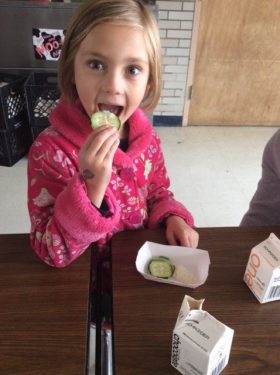Build a Healthier School Food Culture
On the matter of food, food matters.
 When we talk about food culture at school, we are talking about elevating the traditional pizza and tater tots and offering healthy foods that meet nutrition standards and that kids will enjoy. But it goes way beyond the cafeteria. It’s also about improving what’s offered at school parties and family events, how we reward kids, and how what we eat matches — or doesn’t — what we teach kids about healthy eating, both at home and in school.
When we talk about food culture at school, we are talking about elevating the traditional pizza and tater tots and offering healthy foods that meet nutrition standards and that kids will enjoy. But it goes way beyond the cafeteria. It’s also about improving what’s offered at school parties and family events, how we reward kids, and how what we eat matches — or doesn’t — what we teach kids about healthy eating, both at home and in school.
School food culture: Your school’s philosophy and approach to school meals, snacks, beverages, rewards, celebrations and the experience of eating, for staff and students.
Children spend about 1,200 hours in school every year and many millions of those children rely on school meals for vital nutrition. Creating a healthy school food culture is a critical step toward reversing the national health crisis of obesity and undernourishment facing our children. Plus, let’s face it: it helps you have more control over what your child is consuming when you’re not around. Here’s what a healthy school food culture looks like:
- School policies and practices consistently make the healthy choice the easy and desirable one, including outside the school day and during special events.
- School staff and adult volunteers role model healthy eating habits.
- Students and families receive consistent messages about healthy eating across all aspects of the school, whether it’s in the classroom, the front office, the cafeteria, during snack time, for a reward, at a celebration, sporting or family event or in relation to a fundraiser.
Benefits of a Healthy School Food Culture
- Supports classroom lessons. Policies and practices reflect curriculum standards for health and nutrition rather than conflict with them.
- Encourages consumption of healthy foods. Students regularly consume healthy options in place of nutritionally-empty snacks such as cookies, chips and candy.
- Contributes to good health. Children who practice healthy eating habits are less likely to suffer from conditions such as obesity, diabetes, hypertension and cavities.
- Promotes the right messages. Publicly demonstrates a school’s commitment to promoting healthy behaviors among its students, families and staff, sending the message that health is a top priority.
- Creates excitement about nutrition. When nutritious foods are presented in a fun and engaging way, students are eager to get involved.
- Healthy kids learn better. Research clearly shows that good nutrition is linked to better behavior and academic performance.
Seven Secrets to Success
We know a healthy school food culture is good for our kids, but how do you make it happen? Here are ways to assess what’s happening at school and help your school make healthy choices easy choices for kids and staff:
- Make healthy options standard whenever foods are sold or shared — parties, fundraisers, school events, celebrations and concessions — in and out of the cafeteria and the classroom.
- Make fresh fruits and veggies, water, whole grains and low-fat/fat-free dairy products front and center for students.
- Limit or eliminate unhealthy choices that interfere with nutrition education, send conflicting messages about what we value and make it harder for kids to internalize healthy habits.
- Shift the focus from food to fun — host events and celebrations that promote physical activity, music, art and games.
- Provide students with non-food rewards for good behavior and performance.
- Use school food as an opportunity for nutrition education with school gardens, taste tests, healthy snack time, healthy vending, concessions and school stores.
- Write goals into wellness policies and school improvement plans to build support, track progress and help make a healthy school food culture the new norm.
The research is clear: Students perform better in school when they eat healthier foods. To learn more about how you can help make school meals more nutritious, check out our webinar “Helping Kids Learn Better with Healthy School Meals.”
Categories: Making Change Happen, Meals & Nutrition